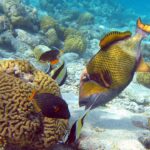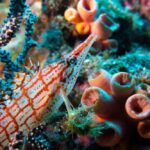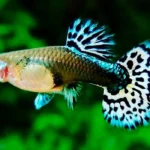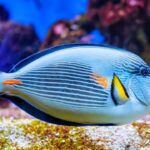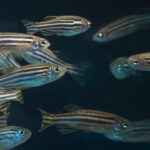Discus Fish In the magical world of freshwater aquariums, few fish are able to claim the throne as comfortably as the discus. With their gorgeous color, long, rounded bodies, and fluid swimming style, discus fish are already renowned as “the kings and queens” of the freshwater hobby. Not only are these intriguing creatures breathtakingly handsome, but they are intelligent, social, and surprisingly convoluted as well. If you have ever been captivated by the silent glide of a discus over mats of water weeds, you know the allure.
But with their regality comes a reputation — delicate, finicky, and finicky. Are they as finicky to keep as everyone says? Is the beauty worth it? This article goes in-depth into all that you should know about discus fish — their history, maintenance, tank setup, feeding, breeding, and the myths that seem to surround them. Let’s take a look at why these dazzling saucers have captivated aquarists for centuries and how you can keep them successfully thriving in your own home.

Origins and Natural Habitat
There are three species.
Symphysodon aequifasciatus—the Blue or Green Discus,
Symphysodon discus—the Heckel Discus, and
Symphysodon tarzoo—the Red Discus.
They live in sluggish tributaries, floodplains, and blackwater environments with acidic, very soft, and dark-stained water from decomposing vegetation. Their environment created their sensitivity — they developed to perform well under stable conditions with minimal fluctuation. Keeping this in mind is the first step in replicating their natural habitat in an aquarium. The flat, disk-like body of the discus makes it easy to navigate between roots, downed branches, and underwater plants. They tend to travel in small schools, displaying what can only be described as social behaviors that suggest complexity.
What Makes Discus Fish Special?
Discus fish are valued for several reasons:
Aesthetic Value: Their bodies are nearly circular, and they have a rainbow of bright colors, from electric blues to burning reds.
Behavior: They are peaceful, smart, and tend to recognize their owners.
Social Structure: Discussions exist in schools and have interesting hierarchy dynamics.
Breeding: Not like most other fish, discus parents actually tend to their fry, even producing a mucus secretion on their bodies that the babies graze on.
This dichotomy of behavior and beauty makes them a showpiece in any aquarium. But it means they need a bit of extra attention.
Setting Up the Perfect Discus Aquarium
Having the environment correct is half the fight in keeping discus healthy. This is how to do it:
Tank Size
Discus are big fish and require room. A 55-gallon tank minimum is advised for a small school (5–6 fish). Larger tanks (75 gallons or more) are preferable for stability and growth.
Water Parameters
Temperature: 82–86°F (28–30°C)
pH: 6.0–7.0 (slightly acidic)
Hardness: Soft (1–4 dgh)
Ammonia/Nitrite: 0 ppm
Nitrate: Under 20 ppm
Discus requires spotless water. 25–50% weekly water changes are necessary.
Filtration
Provide a strong yet delicate filter with a good biofilter system. Canister filters are best. Discus do not enjoy strong currents, so keep the activity at a minimum.
Substrate and Decor
Most discus tanks are bare-bottomed for simplicity of cleaning, particularly in breeding tanks. Fine sand, driftwood, and Amazon-type plants such as
Amazon swords
Java fern
Anubias
Floating plants for shade
Lighting
Moderate lighting is optimal. Highlighting will stress discus, so offer shaded regions with plants or floating cover.

Choosing and Introducing Discus Fish
Buying Healthy Discus
Purchase from trusted breeders or aquarium stores. Check for:
Bright, clear eyes
Rounded body (not pinched)
Healthy appetite
Schooling behavior
No clamped fins or visible parasites
Don’t do impulse purchases — quarantine new fish for 2–3 weeks to avoid disease.
Acclimating Discus
The drip method is optimal. Gradually acclimate them to your tank water conditions within 1–2 hours. Switch off lights while doing so to minimise stress.
Feeding Discus Fish
Discus are finicky to eat, but with persistence, they will be trained to accept a selection of foods.
What to Feed
High-quality pellets: Specially formulated discus pellets (like Hikari or NorthFin)
Frozen foods: Bloodworms, brine shrimp, beef heart (sparingly)
Live foods: Occasionally for enrichment (but ensure they’re parasite-free)
Feeding Schedule
Feed 2–3 times daily. Juvenile fish can be fed more frequently. Remove uneaten food early to prevent fouling the water.
Discus Tankmates — Who Can Live with Royalty?
Discussions are gentle but sensitive. Suitable tankmates need to endure soft, warm water and be just as gentle.
Ideal Tankmates
Cardinal tetras
Rummy nose tetras
Corydoras catfish
Dwarf cichlids (Apistogramma)
Sterbai Corys (they handle warm temps)
Ram cichlids (if not aggressive)
Tankmates to Avoid
Fin nippers (like tiger barbs)
Large, aggressive cichlids
Fast, boisterous fish
Cool-water species (like goldfish)
Carefully watch interactions at all times when adding new fish.

Breeding Discus Fish
Breeding discus is difficult but highly rewarding.
Pairing Off
Discuss forming monogamous pairs. Let a group grow up together, and natural pairs will form at the age of 10–12 months.
Breeding Conditions
Separate breeding tank (30–40 gallons)
Bare bottom
Vertical surface for spawning (cone or pipe)
Temp: 84–86°F
pH: ~6.5
Frequent water changes
Spawning Behavior
The pair will clean the spawning site and spawn. The male fertilizes them, and both parents protect the eggs.
Fry hatch in 2–3 days and eat off the parents’ slime coat. After a week, you can feed baby brine shrimp or powdered food.
Common Problems and How to Solve Them
Disease
Ich (white spot): Treat with heat and medication.
Hexamita (hole in the head): Often caused by poor diet or water quality.
Gill flukes/parasites: Treat with antiparasitics.
Bacterial infections: Caused by poor tank hygiene.
Stress
Poor water quality
Incompatible tankmates
Inadequate temperature
Too much light
The Reward of Keeping Discus
There’s something wonderfully contemplative about viewing discus move through their watery realm. They don’t flash like tetras or school like guppies — they float, look, and play. Owners frequently tell of discus recognizing them at mealtime, following them around the tank, or being interested in what lies beyond the confines of the aquarium.
Their maintenance can be challenging, but the emotional reward is legitimate. You form a connection. You get to know their idiosyncrasies. And when a thriving, radiant discus swims up to you with interest, you realise that these aren’t merely fish —they’re living gems.

Conclusion
Discus fish are not for everybody. They need time, regular care, and a careful eye.
These elegant fish bring an element of beauty, color, and personality that few aquarium fish can offer. Their reputation as finicky, demanding fish might scare off beginners, but the truth is this: with study, patience, and a daily investment of a little bit of time, discus can be just as stunning in a home aquarium as they are in nature.
They will challenge your skills, but they will also introduce you to a peaceful underwater world in which gliding hues drift effortlessly through seeable aquatic plants. You’ll observe courtship, care of offspring, and social organisation that animate the tank with soft drama and gentle interaction.
Discus aren’t just pets —they’re a conversation piece, a stress reliever, and, for many aquarists, a lifelong passion. If you’re willing to embrace their needs and commit to the journey, you’ll soon understand why these magnificent fish are called the jewels of freshwater aquariums.
FAQs
Are discus fish hard to keep?
Discus fish are known to be challenging, but given the right information and maintenance over time, they can thrive. They need stable water parameters, heat, and very good filtration. Not a good option for complete beginners, but easy for anyone with experience with freshwater aquariums and a willingness to perform maintenance.
Can I keep just one discus fish?
It’s not advisable. Discus are schooling fish that occur naturally in schools. Keeping them in isolation can stress them, decrease their activity level, and cause health issues. Always keep them in a minimum of 5–6 to replicate their natural schooling behavior and social demands.
How big do discus fish get?
The adult discus may reach a size of 6–8 inches (15–20 cm) in diameter, depending on strain and maintenance. Due to their size and need for company, a large aquarium is a necessity.
What is the ideal tank size for discus fish?
A minimum of 55 gallons is best for a small group (5–6 fish). For more water stability and comfort, 75 gallons or bigger is ideal. Always provide horizontal swimming space first.
Can discus live with other fish?
Yes, but tankmates should be peaceful, non-aggressive, and tolerant of soft, warm water. The best tankmates are:
Cardinal tetras
Rummy nose tetras
Corydoras catfish
Ram cichlids (cautiously)
Never house fast, nippy, or aggressive fish such as barbs or large cichlids.
What do discus fish eat?
Discussions like to eat a high-protein diet. Feed a combination of:
High-quality discus pellets
Frozen or live bloodworms, brine shrimp
Beef heart (occasionally)
Feed 2-3 small amounts daily and skim off uneaten food to sustain water quality.
How often should I change the water in a discus tank?
A minimum of 25–50% weekly is ideal. In overstocked tanks or breeding tanks, more frequent changes may be needed. Perfect water quality is essential to discus health.


